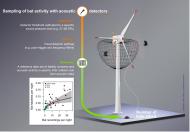An international team of 21 researchers and ecological consultants, including the Museum für Naturkunde Berlin, published a study on the protection of bats at wind turbines in the journal Mammal Review. Against the background of an extensive data set, the authors argue that acoustic recordings can reliably predict the number of bats killed by wind turbines. This can then be used to derive the extent of the adjustments to turbine operation necessary to protect the bats. However, a prerequisite for a reliable collision risk assessment is a standardised survey whose results can be compared and referenced with other datasets.
All bat species are strictly protected by law in Germany. To avoid collisions of bats with wind turbines, the rotors of newer turbines are switched off at times of high bat activity. "We know from many years of research that bats are particularly active in the rotor swept zone at low wind speeds and thus when the turbines produce little or no electricity.
This knowledge, together with the bat activity recorded at a site, is used to program wind turbines for bat-adapted operation," explains Dr Oliver Behr, the first author, bat expert, and ecological consultant at OekoFor GbR who played a leading role in developing the operating guidelines widely used in Germany to protect bats.
Automated ultrasonic detectors installed in the machine housing behind the rotor of the wind turbine record the echolocation calls of bats flying in the rotor zone. The distance at which a bat can be detected by the devices depends, among other things, on the bat species and the trigger level threshold of the ultrasonic microphone used.
Thus, loud, and deep calling bat species such as the common noctule can be detected at greater distances than quieter and higher calling species such as the Nathusius' pipistrelle. However, the detection range of ultrasonic detectors increases considerably when devices with a lower triggering level threshold are used.
When sampling animals for ecological surveys, only a representative sample from the population is required and it is unnecessary to sample exhaustively. Acoustic monitoring of bats at wind turbines represents a particularly extensive survey compared to other environmental impact assessments, as the entire activity period is usually covered. This is a great advantage because the occurrence of bats is characterised by short peaks of activity that are difficult to predict.
"Much more important than the sensitivity and detection range of bat detectors, however, is a standardised and referenced protocol for data acquisition and analysis," explains Dr Martina Nagy from the Museum für Naturkunde Berlin. If, for example, a protocol is used that was specifically developed for the conditions in Central Europe, the measured acoustic activity can be converted into the expected number of bat fatalities.
In the next step, the wind turbines are switched off using specific operating algorithms at times of predicted high bat activity. The method described is widely used in Germany and is integrated into the freely available ProBat software for broad and simple use by operators, environmental consultants, and authorities.
The authors are convinced that this can make a vital contribution to the expansion of renewable energies with a simultaneously limited fatality risk for bats.
Further information
Publication
Oliver Behr, Kévin Barré, Fabio Bontadina, Robert Brinkmann, Markus Dietz, Thierry Disca, Jérémy S. P. Froidevaux, Simon Ghanem, Senta Huemer, Johanna Hurst, Stefan K. Kaminsky, Volker Kelm, Fränzi Korner-Nievergelt, Mirco Lauper, Paul Lintott, Christian Newman; Trevor Peterson, Jasmin Proksch, Charlotte Roemer, Wigbert Schorcht, Martina Nagy, 2023. Standardised and referenced acoustic monitoring reliably estimates bat fatalities at wind turbines: comments on 'Limitations of acoustic monitoring at wind turbines to evaluate fatality risk of bats'. Mammal Review, DOI: https://doi.org/10.1111/mam.12310
Press pictures
For free use in relation with that press release:
- Figure 1: Illustration of a standardised and referenced protocol for determining the collision risk of bats at wind turbines. The graph at the bottom left shows, based on an extensive data set, that the number of bat fatalities at wind turbines can be predicted from acoustic recordings. Picture credits: Behr et al. 2023, Standardised and referenced acoustic monitoring reliably estimates bat fatalities at wind turbines: comments on 'Limitations of acoustic monitoring at wind turbines to evaluate fatality risk of bats'. Mammal Review, DOI: https://doi.org/10.1111/mam.12310. Copyright © 2000-2022 by John Wiley & Sons, Inc. or related companies. All rights reserved.
- Figure 2: Image by Markus Distelrath from Pixabay
More information on bats
- "Baby bats babble like human infants" (press release)
- "Does bat DNA hold the answer to aging well?" (press release)
- "Bugging bats: How and what do bats hear?" (press release)
- Fact sheet on native bats and SARS-CoV 2

